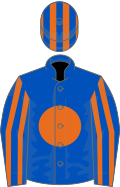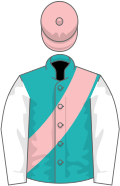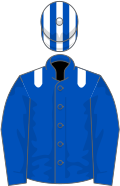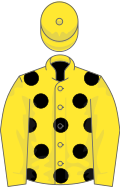Top Qs
Timeline
Chat
Perspective
Ascot Gold Cup
U.K. horse race From Wikipedia, the free encyclopedia
Remove ads
| 2025 | ||
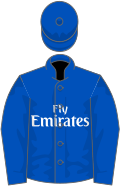 |
 |
 |
| Trawlerman | Illinois | Dubai Future |
The Gold Cup is a Group 1 flat horse race in Great Britain open to horses aged four years or older. It is run at Ascot over a distance of 2 miles 3 furlongs and 210 yards (4,014 metres), and it is scheduled to take place each year in June.

It is Britain's most prestigious event for "stayers" – horses which specialise in racing over long distances. It is traditionally held on the third day of the Royal Ascot meeting, which is known colloquially (but not officially) as Ladies' Day. Contrary to popular belief, the actual title of the race does not include the word "Ascot".
Remove ads
History
Summarize
Perspective
The event was established in 1807,[1] and it was originally open to horses aged three or older. The inaugural winner, Master Jackey, was awarded prize money of 100 guineas. The first race took place in the presence of King George III and Queen Charlotte.
The 1844 running was attended by Nicholas I of Russia, who was making a state visit to England. That year's winner was unnamed at the time of his victory, but he was given the name "The Emperor" in honour of the visiting monarch. In return Nicholas offered a new trophy for the race — the "Emperor's Plate" — and this became the title of the event for a short period. Its original name was restored after nine years, during the Crimean War.
It was taken by thieves on 18 June 1907. The theft was never solved, but a replacement was finished by August. Mark Twain, the American humorist, came to London about that time, and was much amused by the twin headlines appearing in The Times:
MARK TWAIN ARRIVES
ASCOT GOLD CUP STOLEN
The Gold Cup is the first leg of Britain's Stayers' Triple Crown, followed by the Goodwood Cup and the Doncaster Cup. The last horse to win all three races in the same year was Stradivarius in 2019.
The Gold Cup is one of three perpetual trophies at the Royal Ascot meeting, along with the Royal Hunt Cup and the Queen's Vase, which can be kept permanently by the winning owners. A number of horses have won it more than once, and the most successful is Yeats, who recorded his fourth victory in 2009.
Remove ads
Records
Summarize
Perspective
Most successful horse (4 wins):
- Yeats – 2006, 2007, 2008, 2009
Other multiple winners: 3 wins
- Sagaro – 1975, 1976, 1977
- Stradivarius – 2018, 2019, 2020
Other multiple winners: 2 wins
- Anticipation – 1816, 1819
- Bizarre – 1824, 1825
- Touchstone – 1836, 1837
- The Emperor – 1844, 1845
- The Hero – 1847, 1848
- Fisherman – 1858, 1859
- Isonomy – 1879, 1880
- The White Knight – 1907, 1908
- Prince Palatine – 1912, 1913
- Invershin – 1928, 1929
- Trimdon – 1931, 1932
- Fighting Charlie – 1965, 1966
- Le Moss – 1979, 1980
- Ardross – 1981, 1982
- Gildoran – 1984, 1985
- Sadeem – 1988, 1989
- Drum Taps – 1992, 1993
- Kayf Tara – 1998, 2000
- Royal Rebel – 2001, 2002
- Kyprios - 2022, 2024
Leading jockey (11 wins):
- Lester Piggott – Zarathustra (1957), Gladness (1958), Pandofell (1961), Twilight Alley (1963), Fighting Charlie (1965), Sagaro (1975, 1976, 1977), Le Moss (1979), Ardross (1981, 1982)
Leading trainer (9 wins):
- Aidan O'Brien – Yeats (2006, 2007, 2008, 2009), Fame and Glory (2011), Leading Light (2014), Order of St George (2016), Kyprios (2022,2024)
Leading owner (9 wins): (includes part ownership)
- Sue Magnier – Yeats (2006, 2007, 2008, 2009), Fame and Glory (2011), Leading Light (2014), Order of St George (2016), Kyprios (2022,2024)
Remove ads
Winners
- The race was run at Newmarket during the wartime periods of 1917–18 and 1941–44
- Royal Gait was first in 1988, but he was relegated to last place following a stewards' inquiry
- The 2005 running took place at York
Remove ads
See also
References
External links
Wikiwand - on
Seamless Wikipedia browsing. On steroids.
Remove ads

















